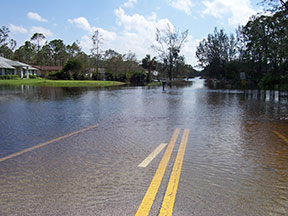Emergency Management
 The South Indian River Water Control District is responsible for roads and canals within its jurisdiction. In the event of a natural or man-made catastrophe, emergency management emphasis would be placed on cleaning debris from roadways and providing ingress/egress for residents, as well as medical and law enforcement agencies.
The South Indian River Water Control District is responsible for roads and canals within its jurisdiction. In the event of a natural or man-made catastrophe, emergency management emphasis would be placed on cleaning debris from roadways and providing ingress/egress for residents, as well as medical and law enforcement agencies.
Major canal systems would also be prioritized for removal of trees or debris obstructing optimum stormwater outfall capabilities. Individual emergencies would also be responded to as conditions permit.
South Indian River Water Control District is part of a larger emergency management plan under the direction of the Palm Beach County Emergency Management Office. This plan effectively makes District equipment available for designated areas outside District boundaries, but would not be activated until such time as the primary obligations to the District residents' health, safety, and welfare were met.
In the event of imminent hurricane and flooding danger, District operations personnel would secure the equipment and facilities against damage. They would then be allowed to return to their homes to protect their personal property and family during the event. Immediately following the storm's passage, District personnel would return to their duty posts and begin operations as described above.
If structures in the District sustain substantial damage resulting in building debris, the District will designate specific areas for residents to haul their debris. The District will then coordinate the removal of such debris with the county authorities.
The District offices also could be designated as an emergency shelter or distribution center for water and emergency supplies.
Evacuation Routes
Since the District is not in the primary surge zone, there are no specified evacuation routes. It is important to note that if major flooding does occur, there could be some isolated areas that could become impassable. With this in mind, a 72-hour notice is provided so that you can evacuate the area should you wish to do so. Due to the heavy traffic volume anticipated, you should allow adequate time for any evacuation.
Additional information is available from the Emergency Management Division.
Getting Ready and After the Storm
All residents the District are urged to follow the recommendations listed in the Hurricane Guides available from Publix and local TV stations, as well as Palm Beach County information. It is important to prepare for any such storm emergency well in advance.
- Prior to each hurricane season, stock up on non-perishable foods and water, lanterns and flashlights, battery-operated fans and batteries, trim and prune trees on your property, and clean up yard debris.
- If a storm watch is issued, watch your local stations for updates as to the progress of the storm.
- If a storm warning is issued, you should put up storm shutters or plywood, secure any loose items such as toys, bicycles, yard tools, potted plants and outdoor furniture.
- Fill up your gas tank early and if you have a generator get enough gas to last for a few days.
- Pick up some food and water if needed, and make plenty of ice to keep food cold. A handy tip is to freeze plastic bags or jugs full of water as they take a long time to thaw and will last longer. Stock up on necessary medications prior to the storm.
- If you have a through-the door ice maker - remove the ice and put it in a plastic bag so it won't melt and drain onto your floor when the power goes out. If you have a traditional land-line phone, keep at least one non-cordless model in your home because it will still work if you lose power.
- Secure all important papers and documents in water-proof containers. Prepare a family contact sheet should your cell phone lose power and you need to contact them another way. Identify a contact, such as a relative or friend that lives out of state for household members to notify they are safe. If is often easier to make a long-distance call than to someone across town, and the out of the area contact may be in a better position to communicate among separated family members. Keep your contact lists updated across all your media channels for easier communication.
- Immediately following a storm or other disaster, try not to use your mobile devices for networking-clogging services such as streaming videos or large downloads - limiting these services can help potentially life-saving emergency calls get through to 911. Keep all phone calls brief and for non-emergency communications use text messaging, e-mail or social media to avoid tying up voice networks. If power is off for an extended time, you can charge your cell phone in your car or with solar powered chargers.
- After a storm passes, keep off the roadways so that debris can be cleared and stay out of stormwater as it can contain bacteria, oils, pesticides, chemicals, downed power lines and even snakes.
Equally important, is for all residents to follow the established procedures after any emergency and exercise patience and understanding. This will help to eliminate unnecessary confusion and delays. Full cooperation should be extended to the authorities in a concentrated effort to deal with any emergency occurring in the District.
Stay informed. Palm Beach County now offers a free PBC DART app for smart phones for up-to-the-minute emergency information.
Download the apps at these URLs:
https://apps.apple.com/us/app/pbc-dart/id526473189
https://play.google.com/store/apps/details?id=org.pbcgov.pbcdart2
Palm Beach County Hurricane Guidance Website
Palm Beach County Hurricane Guide
Palm Beach County Hurricane Supply Checklist